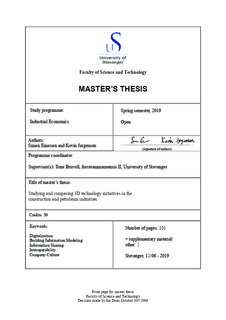| dc.contributor.advisor | Bruvoll, Tone | |
| dc.contributor.author | Einarsen, Simen | |
| dc.contributor.author | Jørgensen, Kevin | |
| dc.date.accessioned | 2019-11-11T12:28:47Z | |
| dc.date.available | 2019-11-11T12:28:47Z | |
| dc.date.issued | 2019-06 | |
| dc.identifier.uri | http://hdl.handle.net/11250/2627720 | |
| dc.description | Master's thesis in Industrial economics | nb_NO |
| dc.description.abstract | The rapid advancements of new technologies paired with an increasing focus on both cutting costs and reducing carbon footprints is driving the world's industries towards a digital transformation. Despite technologically advanced petroleum extraction methods, the oil \& gas sector is considered by many to be among the least digitalized industries. Another sector viewed to be lagging in the digitalization era is the construction industry. The introduction of Building Information Modeling (BIM) saw this sector take its first step towards a digital transformation. Enhanced collaboration, insight, and communication has seen BIM technology become widespread and accepted throughout the industry.
The benefits of BIM are investigated and used as an inspiration to see how the oil \& gas sector deploy similar technologies and processes. The objective is to compare the use of these technologies and shed light upon potential transferable cross-industry learning. In addition to explicating presently used tools and processes, this thesis answers where initiatives for the use of 3D modeling tools arise and which role company culture plays in the adoption of these technologies. The findings are based on qualitative studies, achieved through interviews with representatives from both the construction and petroleum industry. In symbiosis with a literature review, these findings represent the foundation for the conclusions drawn in this thesis.
Results reveal that the initiatives for employing 3D modeling tools differ between the two industries. However, the main driver within both sectors is enthusiastic individuals attempting to force their firm to adopt new technologies. The findings revealed a corporate culture of resisting these technologies in order to hinder potential changes in work processes. In the petroleum industry, an insufficient inter- and intra-organizational flow of quality information was identified, resulting in a lack of an inter-subjective understanding of available relevant technologies. BIM technology is used in construction as a useful communication tool both within the company and with other companies in the supply chain. Also, the IFC standard was found to have solved problems of interoperability among different applications.
It was concluded that one of the major obstacles for the embrace of technologies like 3D modeling tools, in the petroleum industry, is insufficient awareness of available technologies and how to use them. Also, learning from the implementation of BIM could prove useful for Equinor when attempting to achieve full interoperability of their 3D modeling tools. The UK is reaping benefits from its pole position in the international construction market, as a result of their BIM expertise. Within 3D technology, Equinor has a comparable position in the petroleum industry and could utilize this to achieve similar benefits. | nb_NO |
| dc.language.iso | eng | nb_NO |
| dc.publisher | University of Stavanger, Norway | nb_NO |
| dc.relation.ispartofseries | Masteroppgave/UIS-TN-ISØP/2019; | |
| dc.rights | Navngivelse 4.0 Internasjonal | * |
| dc.rights.uri | http://creativecommons.org/licenses/by/4.0/deed.no | * |
| dc.subject | industriell økonomi | nb_NO |
| dc.subject | petroleumsteknologi | nb_NO |
| dc.title | Studying and comparing 3D technology initiatives in the construction and petroleum industries | nb_NO |
| dc.type | Master thesis | nb_NO |
| dc.subject.nsi | VDP::Social science: 200::Economics: 210 | nb_NO |
| dc.subject.nsi | VDP::Technology: 500 | nb_NO |

